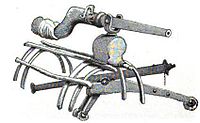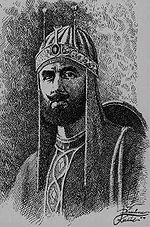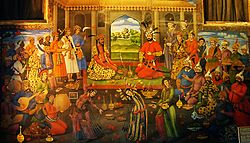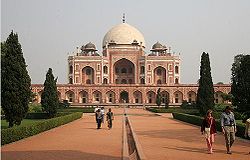- Humayun
-
- for the film see Humayun (film)
Humayun  2nd Mughal Emperor of India
2nd Mughal Emperor of IndiaReign 26 December 1530 – 17 May 1540
(9 years, 143 days)
22 February 1555 – 27 January 1556
(0 years, 339 days)Coronation 30 December 1530, Agra Predecessor Babur Successor Akbar Spouse Hamida Banu Begum
Bega Begum
Bigeh Begum
Haji Begum
Mah-chuchak
Miveh Jan
Shahzadi KhanumIssue Akbar, son
Mirza Muhammad Hakim, son
Aqiqeh Begum, daughter
Bakshi Banu Begum, daughterFather Babur Mother Maham Begum Born 17 March 1508
KabulDied 27 January 1556 (age 47)
DelhiBurial Humayun's Tomb Religion Islam Nasir ud-din Muhammad Humayun (Persian: نصیر الدین محمد همایون; full title: Al-Sultan al-'Azam wal Khaqan al-Mukarram, Jam-i-Sultanat-i-haqiqi wa Majazi, Sayyid al-Salatin, Abu'l Muzaffar Nasir ud-din Muhammad Humayun Padshah Ghazi, Zillu'llah; OS 7 March 1508–OS 22 February 1556) was the second Mughal Emperor who ruled present day Afghanistan, Pakistan, and parts of northern India from 1530–1540 and again from 1555–1556. Like his father, Babur, he lost his kingdom early, but with Persian aid, he eventually regained an even larger one. On the eve of his death in 1556, the Mughal empire spanned almost one million square kilometers.
He succeeded his father in India in 1530, while his half-brother Kamran Mirza, who was to become a rather bitter rival, obtained the sovereignty of Kabul and Lahore, the more northern parts of their father's empire. He originally ascended the throne at the age of 22 and was somewhat inexperienced when he came to power.
Humayun lost Mughal territories to the Pashtun noble, Sher Shah Suri, and, with Persian aid, regained them 15 years later. Humayun's return from Persia, accompanied by a large retinue of Persian noblemen, signaled an important change in Mughal court culture, as the Central Asian origins of the dynasty were largely overshadowed by the influences of Persian art, architecture, language and literature and also there are many stone carved and Persian language In India from the time of humayun also thousands of Persian manuscript in India..
Subsequently, in a very short time, Humayun was able to expand the Empire further, leaving a substantial legacy for his son, Akbar. His peaceful personality, patience and non-provocative methods of speech earned him the title Insan-i-Kamil, among the Mughals.[1]
Contents
Background
Babur's decision to divide the territories of his empire between two of his sons was unusual in India, but it had been a common Central Asian practice since the time of Genghis Khan. Unlike most European Monarchies which practised primogeniture, the Timurids, following Genghis Khan's example, did not leave an entire kingdom to the eldest son. Although under that system only a Chingissid could claim sovereignty and khanal authority, any male Chinggisid within a given sub-branch (such as the Timurids) had an equal right to the throne.[2] While Genghis Khan's Empire had been peacefully divided between his sons upon his death, almost every Chinggisid succession since had resulted in fratricide.[3]
Timur himself had divided his territories between Pir Muhammad, Miran Shah, Khalil Sultan and Shah Rukh, which resulted in inter-family warfare.[2] Upon Babur's death, Humayun's territories were the least secure. Babur had ruled only four years, and not all umarah (nobles) viewed Humayun as the rightful ruler. Indeed earlier, when Babur had become ill, some of the nobles had tried to install Humayun's uncle, Mahdi Khwaja, as ruler. Although this attempt failed, it was a sign of problems to come.[4]
Personal traits
Humayun was portrayed in the biography Humāyūn-nāma written by his sister Gulbadan Begum, as being extraordinarily lenient, constantly forgiving acts which were deliberately aimed at angering him. In one instance the biography records that his youngest brother Hindal killed Humayun's most trusted advisor, an old Sheikh, and then marched an army out of Agra. Humayun, rather than seek retribution, went straight to his mother's home where Gulbadan Begum was, bearing no grudge against his younger brother, and insisted he return home. Humayun was loyal, gentle and humane man by the standards of the day. As a warrior he had served honorably alongside his father Babur during the Battle of Khanwa while he was just seventeen years old.
He was interested in poetry and fascinated by Astrology and the Occult. Upon his accession as Padishah (Emperor), he began to re-organise the administration upon mystically determined principles. The public offices were divided into four distinct groups, for the four elements. The department of Earth was to be in charge of Agriculture and the agricultural sciences, Fire was to be in charge of the Military, Water was the department of the Canals and waterways while Air seemed to have responsibility for everything else. His daily routine was planned in accordance with the movements of the planets, so too was his wardrobe. He refused to enter a house with his left foot going forward, and if anyone else did they would be told to leave and re-enter. His servant, Jauhar, records in the Tadhkirat al-Waqiat that he was known to shoot arrows to the sky marked with either his own name, or that of the Shah of Persia and, depending on how they landed, interpreted this as an indication of which of them would grow more powerful.
Early reign
Upon his succession to the throne, Humayun had two major rivals interested in acquiring his lands — Sultan Bahadur of Gujarat to the south west and Sher Shah Suri (Sher Khan) currently settled along the river Ganges in Bihar to the east. Humayun’s first campaign was to confront Sher Khan Suri. Halfway through the counter offensive Humayun had to abandon it and concentrate on Gujarat, where a threat from Ahmed Shah had to be squelched. In this he succeeded and annexed Gujarat and Malwa. Champaner and the great fort of Mandu followed next.
During the first five years of Humayun's reign, these two rulers were quietly extending their rule, although Sultan Bahadur faced pressure in the east from sporadic conflicts with the Portuguese. While the Mughals had acquired firearms via the Ottoman Empire, Bahadur's Gujurat had acquired them through a series of contracts drawn up with the Portuguese, allowing the Portuguese to establish a strategic foothold in north western India.[5]
Humayun was made aware that the Sultan of Gujarat was planning an assault on the Mughal territories with Portuguese aid. Showing an unusual resolve, Humayun gathered an army and marched on Bahadur. His assault was spectacular and within a month he had captured the forts of Mandu and Champaner. However, instead of pressing his attack and going after the enemy, Humayun ceased the campaign and began to enjoy life in his new forts. Bahadur, meanwhile, escaped and took up refuge with the Portuguese.[6]
Sher Shah Suri
Shortly after Humayun had marched on Gujarat, Sher Shah saw an opportunity to wrest control of Agra from the Mughals. He began to gather his army together hoping for a rapid and decisive siege of the Mughal capital. Upon hearing this alarming news, Humayun quickly marched his troops back to Agra allowing Bahadur to easily regain control of the territories Humayun had recently taken. A few months later, however, Bahadur was dead, killed when a botched plan to kidnap the Portuguese viceroy ended in a fire-fight which the Sultan lost.
Whilst Humayun succeeded in protecting Agra from Sher Shah, the second city of the Empire, Gaur the capital of the vilayat of Bengal, was sacked. Humayun's troops had been delayed while trying to take Chunar, a fort occupied by Sher Shah's son, in order to protect his troops from an attack from the rear. The stores of grain at Gauri, the largest in the empire, were emptied and Humayun arrived to see corpses littering the roads.[7] The vast wealth of Bengal was depleted and brought East giving Sher Shah a substantial war chest.[5]
Sher Shah withdrew to the east, but Humayun did not follow: instead he "shut himself up for a considerable time in his Harem, and indulged himself in every kind of luxury."[7] Hindal, Humayun's 19-year old brother, had agreed to aid him in this battle and protect the rear from attack but abandoned his position and withdrew to Agra where he decreed himself acting emperor. When Humayun sent the grand Mufti, Sheikh Buhlul, to reason with him, the Sheikh was killed. Further provoking the rebellion, Hindal ordered that the Khutba or sermon in the main mosque at Agra be read in his name, a sign of assumption of sovereignty.[6] When Hindal withdrew from protecting the rear of Humayun's troops, Sher Shah's troop quickly reclaimed these positions, leaving Humayun surrounded.[8]
Humayun's other brother, Kamran, marched from his territories in the Punjab, ostensibly to aid Humayun. However, his return home had treacherous motives as he intended to stake a claim for Humayun's apparently collapsing empire. He brokered a deal with Hindal which provided that his brother would cease all acts of disloyalty in return for a share in the new empire which Kamran would create once Humayun was deposed.[8]
Sher Shah met Humayun in battle on the banks of the Ganges, near Benares, in Chausa. This was to become an entrenched battle in which both sides spent a lot of time digging themselves into positions. The major part of the Mughal army, the artillery, was now immobile, and Humayun decided to engage in some diplomacy using Muhammad Aziz as ambassador. Humayun agreed to allow Sher Shah to rule over Bengal and Bihar, but only as provinces granted to him by his Emperor, Humayun, falling short of outright sovereignty. The two rulers also struck a bargain in order to save face: Humayun's troops would charge those of Sher Shah whose forces then retreat in feigned fear. Thus honour would, supposedly, be satisfied.[9]
Once the Army of Humayun had made its charge and Sher Shah's troops made their agreed-upon retreat, the Mughal troops relaxed their defensive preparations and returned to their entrenchments without posting a proper guard. Observing the Mughals' vulnerability, Sher Shah reneged on his earlier agreement. That very night, his army approached the Mughal camp and finding the Mughal troops unprepared with a majority asleep, they advanced and killed most of them. The Emperor survived by swimming the Ganges using an air filled "water skin," and quietly returned to Agra.[5][8]
In Agra
When Humayun returned to Agra, he found that all three of his brothers were present. Humayun once again not only pardoned his brothers for plotting against him, but even forgave Hindal for his outright betrayal. With his armies travelling at a leisurely pace, Sher Shah was gradually drawing closer and closer to Agra. This was a serious threat to the entire family, but Humayun and Kamran squabbled over how to proceed. Kamran withdrew after Humayun refused to make a quick attack on the approaching enemy, instead opting to build a larger army under his own name. When Kamran returned to Lahore, his troops followed him shortly afterwards, and Humayun, with his other brothers Askari and Hindal, marched to meet Sher Shah just 240 kilometres (150 mi) east of Agra at the Battle of Kanauj on 17 May 1540. The battle once again saw Humayun make some tactical errors, and his army was soundly defeated. He and his brothers quickly retreated back to Agra, humiliated and mocked along the way by peasants and villagers. They chose not to stay in Agra, and retreated to Lahore, though Sher Shah followed them, founding the short-lived Sur Dynasty of northern India with its capital at Delhi.
In Lahore
The four brothers were united in Lahore, but every day they were informed that Sher Shah was getting closer and closer. When he reached Sirhind, Humayun sent an ambassador carrying the message "I have left you the whole of Hindustan (i.e. the lands to the East of Punjab, comprising most of the Ganges Valley). Leave Lahore alone, and let Sirhind be a boundary between you and me." Sher Shah, however, replied "I have left you Kabul. You should go there." Kabul was the capital of the empire of Humayun's brother Kamran Mirza, who was far from willing to hand over any of his territories to his brother. Instead, Kamran approached Sher Shah, and proposed that he actually revolt against his brother and side with Sher Shah in return for most of the Punjab. Sher Shah dismissed his help, believing it not to be required, though word soon spread to Lahore about the treacherous proposal and Humayun was urged to make an example of Kamran and kill him. Humayun refused, citing the last words of his father, Babur "Do nothing against your brothers, even though they may deserve it."[10]
Withdrawing further
Humayun decided that it would be wise to withdraw still further, Humayun and his army rode out through and across the Thar Desert, when the Hindu Rajput ruler Rao Maldeo Rathore allied himself with Sher Shah Suri against the Mughal Empire. In many accounts Humayun mentions how he and his heavily pregnant wife, had to trace their steps through the desert at the hottest time of year. All the wells had been filled with sand by the nearbyHindu inhabitants in order to starve and exhaust the Mughals further, leaving them with nothing but berries to eat. When Hamida's horse died,no one would lend the Queen (who was now eight months pregnant) a horse, so Humayun did so himself, resulting in him riding a camel for six kilometeres (four miles), although Khaled Beg then offered him his mount. Humayun was later to describe this incident as the lowest point in his life.[11]
He asked that his brothers join him as he fell back into Sindh. While the previously rebellious Hindal Mirza remained loyal and was ordered to join his brothers in Kandahar. Kamran Mirza and Askari Mirza instead decided to head to the relative peace of Kabul. This was to be a definitive schism in the family.
Humayun expected aid from the Emir of Sindh, Hussein Umrani, whom he had appointed and who owed him his allegiance. The Emir Hussein Umrani welcomed Humayun's presence and was loyal to Humayin just as he had been loyal to Babur against the renegade Arghuns. Whilst in the oasis garrison of Umerkot in Sindh, Hamida gave birth to Akbar on 25 October 1542, the heir-apparent to the 34-year old Humayun. The date was special because Humayun consulted his Astronomer to utilize the astrolabe and check the location of the planets.
While in Sindh, Humayun alongside Emir Hussein Umrani, gathered horses and weapons and formed new alliances that helped regain lost territories. Until finally Humayun had gathered hundreds of Sindhi and Baloch tribesmen alongside his Mughals and then marched towards Kandahar and later Kabul, thousands more gathered by his side as Humayun continually declared himself the rightful Timurid heir of the first Mughal Emperor Babur.
Retreat to Kabul
After Humayun set out from his expedition in Sindh, along with 300 camels (mostly wild) and 2000 loads of grain, he set off to join his brothers in Kandahar after crossing the Indus River on 11 July 1543 along with the ambition to regain the Mughal Empire and overthrow the Suri dynasty.
In Kamran Mirza's territory, Hindal Mirza had been placed under house arrest in Kabul after refusing to have the Khutba recited in Kamran Mirza's name. His other brother Askari Mirza was now ordered to gather an army and march on Humayun. When Humayun received word of the approaching hostile army he decided against facing them, and instead sought refuge elsewhere. Akbar was left behind in camp close to Kandahar for, as it was December it would have been too cold and dangerous to include the 14-month old toddler in the forthcoming march through the dangerous and snowy mountains of the Hindu Kush. Askari Mirza found Akbar in the camp, and embraced him, and allowed his own wife to parent him, she apparently treated him as her own.
Once again Humayun turned toward Kandahar where his brother Kamran Mirza was in power, but he received no help and had to seek refuge with the Shah of Persia.[12]
Refuge in Persia
Humayun fled to the refuge of the Safavid Empire in Iran, marching with 40 men and his wife and her companion through mountains and valleys. Amongst other trials the Imperial party were forced to live on horse meat boiled in the soldiers' helmets. These indignities continued during the month it took them to reach Herat, however after their arrival they were reintroduced to the finer things in life. Upon entering the city his army was greeted with an armed escort, and they were treated to lavish food and clothing. They were given fine accommodations and the roads were cleared and cleaned before them. Shah Tahmasp, unlike Humayun's own family, actually welcomed the Mughal, and treated him as a royal visitor. Here Humayun went sightseeing and was amazed at the Persian artwork and architecture he saw: much of this was the work of the Timurid Sultan Husayn Bayqarah and his ancestor, princess Gauhar Shad, thus he was able to admire the work of his relatives and ancestors at first hand. He was introduced to the work of the Persian miniaturists, and Kamaleddin Behzad had two of his pupils join Humayun in his court. Humayun was amazed at their work and asked if they would work for him if he were to regain the sovereignty of Hindustan: they agreed. With so much going on Humayun did not even meet the Shah until July, some six months after his arrival in Persia. After a lengthy journey from Herat the two met in Qazvin where a large feast and parties were held for the event. The meeting of the two monarchs is depicted in a famous wall-painting in the Chehel Sotoun (Forty Columns) palace in Esfahan.
The Shah urged that Humayun convert from Sunni to Shia Islam, and Humayun eventually and reluctantly accepted, in order to keep himself and several hundred followers alive[13]. Although the Mughals initially disagreed to their conversion they knew that with this outward acceptance of Shi'ism, Shah Tahmasp was eventually prepared to offer Humayun more substantial support.[13] When Humayun's brother, Kamran Mirza, offered to cede Kandahar to the Persians in exchange for Humayun, dead or alive, Shah Tahmasp refused. Instead the Shah threw a party for Humayun, with 300 tents, an imperial Persian carpet, 12 musical bands and "meat of all kinds". Here the Shah announced that all this, and 12,000 choice cavalry were his to lead an attack on his brother Kamran. All that Shah Tahmasp asked for was that, if Humayun's forces were victorious, Kandahar would be his.
Kandahar and onwards
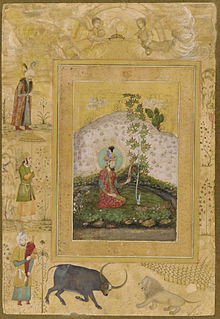 An image from an album commissioned by Shah Jahan shows Humayun sitting beneath a tree in his garden in India.
An image from an album commissioned by Shah Jahan shows Humayun sitting beneath a tree in his garden in India.
With this Persian Safavid aid Humayun took Kandahar from Askari Mirza after a two-week siege. He noted how the nobles who had served Askari Mirza quickly flocked to serve him, "in very truth the greater part of the inhabitants of the world are like a flock of sheep, wherever one goes the others immediately follow". Kandahar was, as agreed, given to the Shah of Persia who sent his infant son, Murad, as the Viceroy. However, the baby soon died and Humayun thought himself strong enough to assume power.
Humayun now prepared to take Kabul, ruled by his brother Kamran Mirza. In the end, there was no actual siege. Kamran Mirza was detested as a leader and as Humayun's Persian army approached the city hundreds of Kamran Mirza's troops changed sides, flocking to join Humayun and swelling his ranks. Kamran Mirza absconded and began building an army outside the city. In November 1545, Hamida and Humayun were reunited with their son Akbar, and held a huge feast. They also held another, larger, feast in the childs' honour when he was circumcised.
However, while Humayun had a larger army than his brother and had the upper hand, on two occasions his poor military judgement allowed Kamran Mirza to retake Kabul and Kandahar, forcing Humayun to mount further campaigns for their recapture. He may have been aided in this by his reputation for leniency towards the troops who had defended the cities against him, as opposed to Kamran Mirza, whose brief periods of possession were marked by atrocities against the inhabitants who, he supposed, had helped his brother.
His youngest brother, Hindal Mirza, formerly the most disloyal of his siblings, died fighting on his behalf. His brother Askari Mirza was shackled in chains at the behest of his nobles and aides. He was allowed go on Hajj, and died en route in the desert outside Damascus.
Humayun's other brother, Kamran Mirza, had repeatedly sought to have Humayun killed, and when in 1552 he attempted to make a pact with Islam Shah, Sher Shah's successor, he was apprehended by a Gakhar. The Gakhars were one of only a few groups of people who had remained loyal to their oath to the Mughals. Sultan Adam of the Gakhars handed Kamran Mirza over to Humayun. Humayun was tempted to forgive his brother, however he was warned that allowing Kamran Mirza's continuous acts to go unpunished could foment rebellion within his own ranks. So, instead of killing his brother, Humayun had Kamran Mirza blinded which would end any claim to the throne. He sent him on Hajj, as he hoped to see his brother absolved of his hateful sins, but he died close to Mecca in the Arabian Peninsula in 1557.
India revisited
 The Mughal Emperor Humayun, gathered a vast army and attempted the challenging task of retaking the throne in Delhi.
The Mughal Emperor Humayun, gathered a vast army and attempted the challenging task of retaking the throne in Delhi.
Sher Shah Suri had died in 1545; his son and successor Islam Shah died too, in 1554. These two deaths left the dynasty reeling and disintegrating. Three rivals for the throne all marched on Delhi, while in many cities leaders tried to stake a claim for independence. This was a perfect opportunity for the Mughals to march back to India. Humayun placed the army under the able leadership of Bairam Khan. This was a wise move given Humayun's own record of military ineptitude, and turned out to be prescient, as Bairam was to prove himself a great tactician.
Marriage relations with the Khanzadas
The Gazetteer of Ulwur states:
Soon after Babar's death, his successor, Humayun, was in AD 1540 supplanted by the Pathan Sher Shah, who, in AD 1545, was followed by Islam Shah. During the reign of the latter a battle was fought and lost by the Emperor's troops at Firozpur Jhirka, in Mewat, on which, however, Islam Shah did not loose his hold. Adil Shah, the third of the Pathan interlopers, who succeeded in AD 1552, had to contend for the Empire with the returned Humaiyun.[14]
In these struggles for the restoration of Babar's dynasty Khanzadas apparently do not figure at all. Humaiyun seems to have conciliated them by marrying the elder daughter of Jamal Khan, nephew of Babar's opponent, Hasan Khan, and by causing his great minister, Bairam Khan, to marry a younger daughter of the same Mewatti.[14]
Bairam Khan led the army through the Punjab virtually unopposed. The fort of Rohtas, which was built in 1541-43 by Sher Shah Suri to crush the Gakhars who were loyal to Humayun, was surrendered without a shot by a treacherous commander. The walls of the Rohtas Fort measure up to 12.5 meters in thickness and up to 18.28 meters in height. They extend for 4 km and feature 68 semi-circular bastions. Its sandstone gates, both massive and ornate, are thought to have exerted a profound influence on Mughal military architecture.
The only major battle faced by Humayun's armies was against Sikander Suri in Sirhind, where Bairam Khan employed a tactic whereby he engaged his enemy in open battle, but then retreated quickly in apparent fear. When the enemy followed after them they were surprised by entrenched defensive positions and were easily annihilated.
From here on most towns and villages chose to welcome the invading army as it made its way to the capital. On 23 July 1555, Humayun once again sat on Babur's throne in Delhi.
Ruling North India again
With all of Humayun's brothers now dead, there was no fear of another usurping his throne during military campaigns. He was also now an established leader, and could trust his generals. With this new-found strength Humayun embarked on a series of military campaigns aimed at extending his reign over areas to East and West India.
His sojourn in exile seems to have reduced Humayun's reliance on astrology, and his military leadership instead imitated the methods he had observed in Persia, allowing him to win more effectively and quicker.
This also applied to the administration of the empire. Persian methods of governance were imported into North India in Humayun's reign. The system of revenue collection is held to have improved on both the Persian model and that of the Delhi Sultanate one. The Persian arts too were very influential, and Persian-style miniatures were produced at Mughal (and subsequently Rajput) courts. The Chaghatai language, in which Babur had written his memoirs, disappeared almost entirely from the culture of the courtly elite, and Akbar could not speak it. Later in life, Humayun himself is said to have spoken in Persian verse more often than not.
Trusted Generals
After defeating Bahadur Shah's confederacy in Gujarat, Humayun placed the following Generals in Gujarat:
- Mirza Askurry at Ahmedabad
- Yadgar Nasir at Patan
- Kasim Hussein Sultan in Bharoach
- Hindu Beg in Baroda
- Tardy Beg Khan in Champaner
However, these officials and generals could not contain uprisings and left Gujarat to be occupied by Bahadur Shah again.
Death and legacy
On 27 January 1556, Humayun, with his arms full of books, was descending the staircase from his library when the muezzin announced the Adhan (the call to prayer). It was his habit, wherever he heard the summons, to bow his knee in holy reverence. Kneeling, he caught his foot in his robe, tumbled down several steps and hit his temple on a rugged stone edge. He died three days later, and was succeeded by the 13-year old Akbar.References
- ^ http://books.google.com/books?id=uB1uAAAAMAAJ&q=Humayun&source=gbs_word_cloud_r&cad=6
- ^ a b Sharaf Al-Din: "Zafar-nama".
- ^ Svat Soucek: "A History of Inner Asia".
- ^ Nizamuddin Ahmad: "Tabaqat-i-Akbari".
- ^ a b c Rama Shankar Avasthy: "The Mughal Emperor Humayun".
- ^ a b S.K. Banjerji: "Humayun Badshah".
- ^ a b Jauhar: "Tadhkirat al-Waqiat".
- ^ a b c Bamber Gascoigne: "The Great Moghuls".
- ^ Badauni: "Muntakhab al-Tawarikh".
- ^ Abul-Fazel: "Akbar-nama".
- ^ http://www.columbia.edu/itc/mealac/pritchett/00islamlinks/ikram/part2_10.html
- ^ http://www.columbia.edu/itc/mealac/pritchett/00islamlinks/ikram/part2_10.html
- ^ a b John F. Richards, Gordon Johnson (1996). Cambridge University Press. ed. The Mughal Empire (illustrated, reprint ed.). p. 11. ISBN 0521566037. http://books.google.com/books?id=HHyVh29gy4QC&pg=PA11&dq=Humayun+shia+islam&as_brr=3&client=opera&hl=es.
- ^ a b http://www.archive.org/stream/gazetteerofulwur00powliala#page/8/mode/2up/search/bairam
Further reading
- Begum, Gulbadan; (tr. by Annette S. Beveridge) (1902). Humayun-nama :The history of Humayun. Royal Asiatic Society. http://www.archive.org/details/historyofhumayun00gulbrich.; Persian and English text
- Banerji, S K (1938). Humayun Badshah. Humphrey Milford Oxford University Press. http://www.archive.org/details/humayunbadshah035068mbp.
- ., Jawhar (fl. 1554); (tr. by Charles Stewart) (1832). The Tezkereh Al Vakiāt: Or, Private Memoirs of the Moghul Emperor Humayun. Oriental Translation Fund. http://www.archive.org/details/tezkerehalvakiat00jawhuoft.
- Cambridge History of India, Vol. III & IV, "Turks and Afghan" and "The Mughal Period". (Cambridge) 1928
- Muzaffar Alam & Sanjay Subrahmanyan (Eds.) The Mughal State 1526-1750 (Delhi) 1998
- William Irvine The army of the Indian Moghuls. (London) 1902. (Last revised 1985)
- Bamber Gasgoigne The Great Moghuls (London) 1971. (Last revised 1987)
- Jos Gommans Mughal Warfare (London) 2002
- Peter Jackson The Delhi Sultanate. A Political and Military History (Cambridge) 1999
- John F. Richards The Mughal Empire (Cambridge) 1993
- James Tod Annals & Antiquities of Rajasthan (Oxford) 1920 Ed. Wm Crooke (3rd Edition)
 This article incorporates text from a publication now in the public domain: Chisholm, Hugh, ed (1911). Encyclopædia Britannica (11th ed.). Cambridge University Press.
This article incorporates text from a publication now in the public domain: Chisholm, Hugh, ed (1911). Encyclopædia Britannica (11th ed.). Cambridge University Press.
External links
HumayunBorn: 7 March 1508 Died: 22 February 1556Regnal titles Preceded by
BaburMughal Emperor
1530–1539Succeeded by
Sher Shah Suri
(as Shah of Delhi))Preceded by
Muhammad Adil Shah
(as Shah of Delhi))Mughal Emperor
1555–1556Succeeded by
AkbarCategories:- Mughal emperors
- 1508 births
- 1556 deaths
- 16th-century Indian people
- Accidental deaths from falls
- Indian people of Turkish descent
Wikimedia Foundation. 2010.


